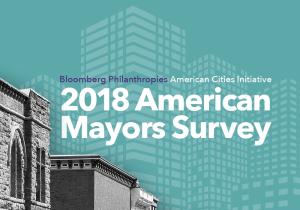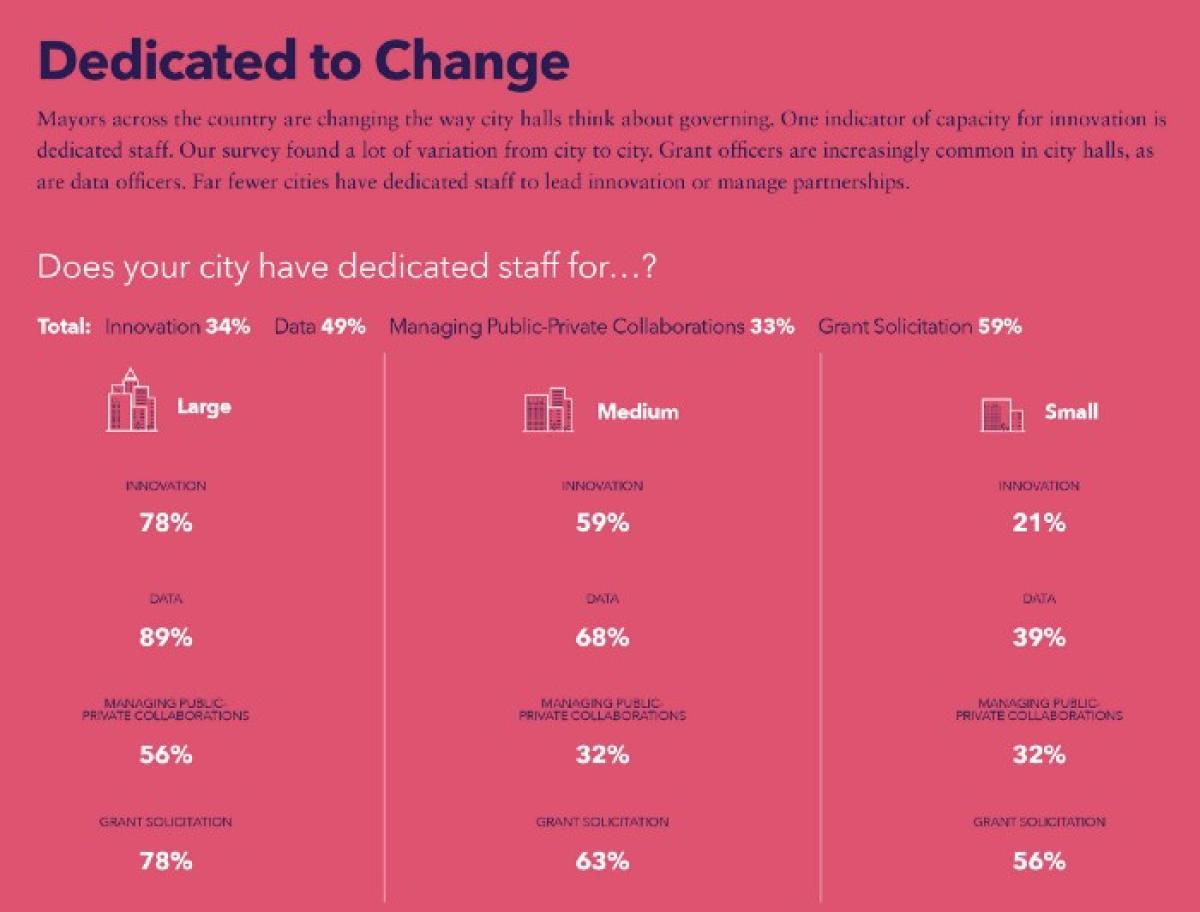Innovation capacity in U.S. city halls: findings from the Bloomberg Mayors Survey

Political dysfunction and gridlock might be the only common denominators on Capitol Hill these days. But real progress is taking shape beyond the Beltway, where city leaders are surmounting formidable obstacles to tackle some of the biggest challenges facing their residents today.
That’s a resounding message to emerge from Bloomberg Philanthropies’ just-released 2018 American Mayors Survey, which finds that mayors — often hamstrung by diminishing budgets and increased state and federal preemption — are adopting new approaches to municipal government, establishing innovation capacity within city hall, and deeply engaging residents in an effort to, quite simply, move their cities and citizens forward.
The survey results, which include responses from 156 cities and from all regions of the country, provide a snapshot of the ways local leaders are responding to mounting challenges like climate change, infrastructure, and the opioid epidemic. They also deliver important insight into the role innovation plays in U.S. cities — its priority in city halls, municipal governments’ capacity for change, and city leaders’ efforts to engage citizens in that change.
Innovation Values
In its work with cities around the world, Bloomberg Philanthropies has found that there are five capacities that are most central to creating a culture of innovation in city halls. Those include BOLD LEADERSHIP (being willing to try new things and taking risks), CITIZEN ENGAGEMENT (including human-centered design), COLLABORATION (with partners inside and outside government and across jurisdictions), DATA-DRIVEN MANAGEMENT (also referred to as performance-based or evidence-based management), and EXPERIMENTATION (prototyping, or testing ideas, learning from the results, and adapting as appropriate).
Not surprisingly, 91 percent of mayors responding to the survey say that engaging residents is very important. Nearly as many (85 percent) see collaboration and partnerships as a core value. While few might think of mayors as using performance-based measures in governing the city, 76 percent say data is also very important to their job as mayor. And mayors value bold leadership (60 percent). The role of prototyping is currently considered less central to mayors (38 percent say it’s very important), which — given the given the value of prototyping in both the private- and public-sector — suggests an opportunity for leaders as they continue to innovate their city halls.
[Read: Unleashing the power of public prototyping]
Innovation Capacity
The capacity to innovate within city hall partially depends upon staffing and, to that end, upon having staff dedicated to key innovation-related functions. The survey demonstrates a lot of variation, from city to city, when it comes to innovation capacity. While 59 percent of cities have grants officers and 49 percent have a chief data officer, only 35 percent have a chief innovation officer and 33 percent have a director of strategic partnerships.
Cities also have a wide range of institutional support for fundraising. Aside from staff positions, only half of cities have a fund or vehicle outside of government to raise money for public programs, mainly centered in large cities (67 percent) and the West (60 percent). Perhaps, then, it is unsurprising that there is a range in the type of collaboration found in city halls. While mayors estimated that city staff collaborate across departments 77 percent of the time, they only seek insights from external partners (e.g., private sector, nonprofits) 64 percent of the time.
Citizen Engagement
Citizen engagement may be the buzzword of the decade, but municipal experiences vary considerably — and not just from city to city. While nearly all mayors engage in informing residents (e.g. press releases, social media), only 26 percent engage in crowdsourcing new ideas. Comparing the types of activities cities use to engage residents, they are most likely to be passive or expecting people to react to something the city has already done. Active engagement, particularly involving citizens in helps solve city problems, is not regularly adopted by mayors.
- Informing residents: 96 percent
- Informing residents: 96 percent
- Soliciting resident feedback: 88 percent
- Volunteerism: 85 percent
- Resident data collection: 53 percent
- Crowdsourcing ideas from residents: 26 percent
According to the survey, cities’ level of citizen engagement looks to be a strong indicator of their overall dedication to and capacity for innovation: Mayors who engage in crowdsourcing ideas from residents are more likely to score high on other indicators linked to building a culture of innovation within city hall. Compared to the overall sample, they are also more likely to have a grants officer (+4 points), chief data officer (+8), chief innovation officer (+11), and a director of strategic partnerships (+5). And they are more likely to find the five innovation capacities as very important, with an emphasis on the role of experimentation or prototyping in government.



